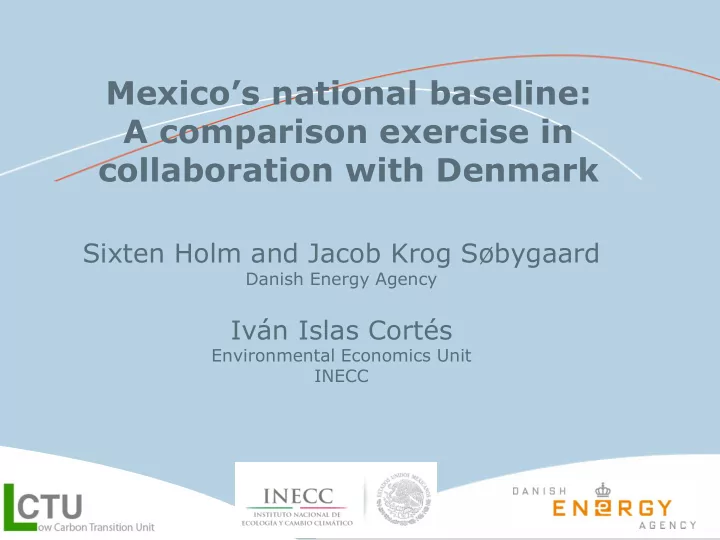

Mexico’s national baseline: A comparison exercise in collaboration with Denmark Sixten Holm and Jacob Krog Søbygaard Danish Energy Agency Iván Islas Cortés Environmental Economics Unit INECC
Modeling capacity in the LCTU • Two tools based on MAC curves from POLES/Enerdata 1. COMPARE • Global emissions trading • Was build up to the COP15 2. Emissions Reduction Tool • Going beyond the MAC • Cost efficient reduction potentials 2
Baseline comparison in Mexico Mt CO 2 e 1200 1000 800 600 400 200 0 2000 2005 2010 2015 2020 2025 2030 Mexico (LEAP) POLES LEAP Mexico (POLES) 3
New publication • Sharing experiences and practices • Suggestions for good practice principles • Transparency • Key Drivers • Sensitivity analysis 4
2013 Mexico’s GHG baseline exercise Why was it necessary to update Mexico’s 2009 baseline? • Transparent and replicable • Traceable: assumptions, methods and source of data • Historical data from 1990 to 2010 • More disaggregation of the data if information is available • Flexible to change key assumptions and easy to use
Sensitivity analysis 1,226 (4.2%) BAU high 1,059 (3.2%) BAU medium 921 (2.2%) BAU low
The POLES reference scenario forecasts lower emissions than LEAP after 2020 INECC 2013 Baseline EnerFuture (Balance Scenario) Emissions associated with energy uses and industrial processes. Other activities such as land use and waste are not covered in POLES and not included in this comparison. 2020 Comparison between POLES and INECC baseline
All macro-economic and activity assumptions Emission wedge The combined differences in macro-economic (population, GDP, and value added in industry) and activity assumptions (steel production, number of dwellings, and transportation parameters) between the models can explain the majority of emissions differences to 2020 There is a widening gap after 2020 due to steadily rising emissions in LEAP and a leveling off in POLES; this leads to the macro-economic and activity differences only accounting for half of the gap by 2030 Comparison between POLES and INECC baseline
Effect of freezing national fuel prices Emission wedge POLES includes both international market prices and national wholesale and final user prices, all of which contribute feedback effects; LEAP does not explicitly include price effects In this scenario, only the national fuel prices inside Mexico are fixed by applying a varying subsidy/tax relative to international fuel prices, so that constant (2009) prices for consumers and industry are maintained A very large emissions increase in this scenario vs. the baseline including all macro-economic and activity effects is due to increased fuel usage in several sectors: transport (increased gasoline and diesel), electricity generation (more oil and gas vs. renewables), and the oil & gas sector (increased auto- consumption) By 2030, this effect is roughly equivalent to providing oil subsidies in the transport sector 4-5 times greater than those applied today in Mexico Comparison between POLES and INECC baseline
Population GDP Relative effects summary VAD Steel Houses Transport Trends Efficiency Prices 11
Conclusions Many of the differences in this study can be attributed to small variations in conversion factors, exchange rates, re-publication and conversion of the same data by different providers, as well as mis-interpretations of sector perimeters and years of data. Overall, for most sectors the historical data used between the models agrees well and a forecast can be generated in POLES that includes most of the broad features from “ Revisada Mas” The differences in activity assumptions have a very strong effect, especially in later years and specifically assumptions about steel production and number of cars and distance travelled While the effect of freezing prices appears to be one of the only drivers capable of bridging the remaining gap between emissions calculated in POLES and LEAP, we feel that incorporating some forecast of future prices is extremely important (whether through endogenous modelling or exogenously when creating consumption forecasts) We recommend using a final baseline incorporating INECC’s assumptions for population, GDP, value added, activity variables (e.g. steel production, number of dwellings, transport), no autonomous consumption trends, and frozen power technology efficiencies is proposed as the final result from the baseline comparison Comparison between POLES and INECC baseline
THANK YOU! Sixten Holm and Jacob Krog Søbygaard Danish Energy Agency Iván Islas Cortés Environmental Economics Unit INECC ivislas@ine.gob.mx
Recommend
More recommend